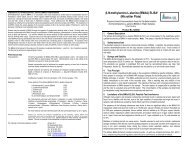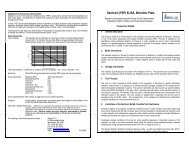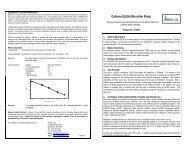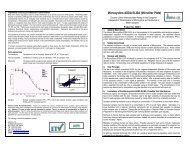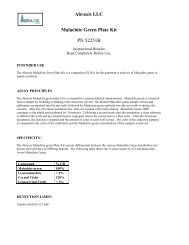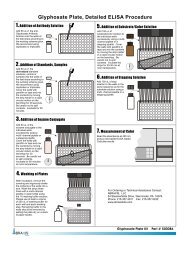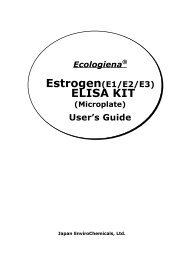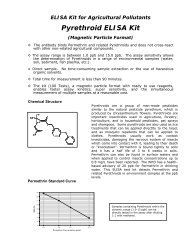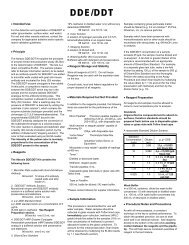Bt Cry1F - Abraxis
Bt Cry1F - Abraxis
Bt Cry1F - Abraxis
Create successful ePaper yourself
Turn your PDF publications into a flip-book with our unique Google optimized e-Paper software.
• Intended Use<br />
For the detection and quantitation of <strong>Bt</strong> <strong>Cry1F</strong> endotoxin residues in<br />
corn seeds and leaf tissues. For use with other sample matrices,<br />
contact the company for application bulletins and/or specific matrix<br />
validation guidelines.<br />
• Principle<br />
The <strong>Abraxis</strong> <strong>Bt</strong> <strong>Cry1F</strong> Microtiter Plate Kit is a “sandwich” enzyme<br />
linked immunosorbent assay (ELISA). In the assay system,<br />
standards and sample extracts are added to microtiter wells coated<br />
with monoclonal antibodies raised against <strong>Bt</strong> <strong>Cry1F</strong> endotoxin. Any<br />
endotoxin residues found in the standard or sample extracts bind to<br />
the antibody coated wells. The “sandwich” is completed by the<br />
addition of polyclonal antibodies raised against the same endotoxin.<br />
An enzyme-labeled conjugate is then added. The enzyme bound to<br />
the wells is measured using a substrate which develops into a<br />
colored product. Since the formation of a “sandwich complex”<br />
occurs only in the presence of a <strong>Cry1F</strong> molecule, the enzyme<br />
activity of the bound sandwich complex is directly proportional to<br />
the amount of endotoxin in the sample.<br />
Lighter color = Lower concentration<br />
Darker color = Higher concentration<br />
A dose response curve of absorbance of the colored product formed<br />
vs. standard concentration is then generated. The concentrations<br />
of <strong>Cry1F</strong> present in the sample extracts are then determined<br />
directly from this curve.<br />
• Reagents<br />
The <strong>Abraxis</strong> <strong>Bt</strong> <strong>Cry1F</strong> Kit contains the following items:<br />
1. <strong>Cry1F</strong> Antibody coated wells<br />
Microtiter plate coated with monoclonal antibody specific for <strong>Cry1F</strong><br />
endotoxin.<br />
12 strips of 8 antibody coated wells<br />
with strip holder (1)<br />
2. <strong>Cry1F</strong> Antiserum Solution<br />
Polyclonal antibody (rabbit) specific for <strong>Cry1F</strong> endotoxin.<br />
One vial containing 11 mL<br />
3. Goat anti-rabbit Enzyme Conjugate Solution<br />
Horseradish peroxidase (HRP) labeled goat anti-rabbit in a buffered<br />
solution with preservative and stabilizers.<br />
One bottle containing 11 mL<br />
4. <strong>Bt</strong> Standards (<strong>Cry1F</strong>)<br />
Seven concentrations (0, 0.25, 0.50, 1.0, 2.0, 4.0, 8.0 ng/mL) of <strong>Bt</strong><br />
calibrators in a buffered solution with preservative and stabilizers.<br />
Each vial containing 1.0 mL<br />
5. Extraction Solution/Sample Diluent (5X) Concentrate<br />
5X concentrated buffered solution with preservative and stabilizers<br />
without any detectable Cry 1F.<br />
One bottle containing 30 mL<br />
6. Color Solution<br />
A solution of hydrogen peroxide and 3,3',5,5'-tetramethylbenzidine<br />
in an organic base.<br />
One bottle containing 12 mL<br />
7. Stopping Solution<br />
A solution of diluted acid.<br />
One bottle containing 12 mL<br />
8. Wash Buffer (5X) Concentrate<br />
5X concentrated buffered salts with detergent and preservatives.<br />
One bottle containing 100 mL<br />
<strong>Bt</strong> <strong>Cry1F</strong><br />
• Reagent Storage and Stability<br />
Store all reagents at 2-8°C. Do not freeze. Reagents may be used<br />
until the expiration date on the box.<br />
Consult state, local and federal regulations for proper disposal of all<br />
reagents.<br />
• Additional Materials Required (Not Provided)<br />
In addition to the reagents provided, the following items are<br />
essential for the performance of the test:<br />
Precision pipettes* capable of delivering 20-200µL, and 200-<br />
1000 µL, with disposable tips.<br />
Multi-channel or stepper pipette* capable of delivering 50-<br />
250µL with disposable tips.<br />
Disposable Tissue Extractors, <strong>Abraxis</strong> PN 510010.<br />
Disposable glass test tubes or glass vials with Teflon lined caps<br />
for dilution of sample extracts.<br />
Balance,* Mettler model AE 100 or equivalent.<br />
Small plastic bags or waxed paper.<br />
Marking pen (indelible).<br />
Tape or Parafilm®.<br />
Timer.<br />
Vortex Mixer,* Thermolyne Maxi Mix, Scientific Industries<br />
Vortex Genie, or equivalent.<br />
Distilled or deionized water for diluting the 5X concentrated<br />
Extraction Solution/Sample Diluent and 5X concentrated Wash<br />
Buffer.<br />
Bottles with 150 mL capacity for the storage of 1X Extraction<br />
Solution/Sample Diluent and 500 mL capacity for storage of 1X<br />
Wash Buffer.<br />
Microplate or strip reader* capable of reading absorbance at<br />
450 nm.<br />
*Please contact <strong>Abraxis</strong> for supplier information.<br />
• Procedural Notes and Precautions<br />
As with all immunoassays, a consistent technique is the key to<br />
optimal performance. To obtain the greatest precision, be sure to<br />
treat each well in an identical manner. Add reagents directly to the<br />
bottom of the well while avoiding contact between the reagents<br />
and the pipette tip. This will help to ensure consistent quantities<br />
of reagent in the test mixture.<br />
Avoid cross-contaminations and carryover of reagents by using<br />
clean pipette tips for each sample addition and by avoiding contact<br />
between reagent droplets on the tubes and pipette tips.<br />
The use of a multi-channel pipette is recommended.<br />
The microtiter plate consists of 12 strips of 8 wells. The<br />
recommended run size is 4 strips or less, as drift may occur.<br />
Remove the unneeded strips and store in the re-sealable foil bag<br />
(with desiccant) provided.<br />
Store refrigerated. Do not use reagents beyond their stated shelf<br />
life. Reagents used in any one assay should be of the same kit lot,<br />
as they have been adjusted in combination.<br />
Avoid contact of Stopping Solution (diluted sulfuric acid) with skin<br />
and mucous membranes. If this reagent comes in contact with skin,<br />
wash with water.<br />
• Limitations<br />
The <strong>Bt</strong> <strong>Cry1F</strong> Assay will detect <strong>Cry1F</strong> and other related endotoxins<br />
to different degrees. Refer to the Specificity section for data on<br />
various <strong>Bt</strong> Cry endotoxins.<br />
• Quality Control<br />
It is recommended that control solutions (negative and positive<br />
solutions) of <strong>Cry1F</strong> be included in every run and treated in the same<br />
manner as unknown samples. Acceptable limits should be<br />
established by each laboratory.<br />
• Reagent Preparation<br />
All reagents must be allowed to come to room temperature prior to<br />
use.<br />
1X Wash Buffer<br />
In a 500 mL container, dilute the 5X concentrated Wash Buffer 1:5<br />
with deionized or distilled water by adding the entire contents of<br />
the 5X concentrated Wash Buffer (100 mL) to 400 mL of deionized<br />
or distilled water. This solution is used to wash the antibody<br />
coated wells. Store refrigerated.<br />
1X <strong>Cry1F</strong> Extraction Solution/Sample Diluent<br />
In a 150 mL container, dilute the 5X concentrated Extraction<br />
Solution/Sample Diluent 1:5 with deionized or distilled water by<br />
adding the entire contents of the 5X concentrated Extraction<br />
Solution/Sample Diluent (30 mL) to 120 mL of deionized or distilled<br />
water. This solution is used for sample extraction and for sample<br />
dilution. Store refrigerated.<br />
• Sample Information<br />
Corn Seed Sample Extraction<br />
1. Weigh a single seed. Record weight.<br />
2. Place seed in a small plastic bag or waxed paper.<br />
3. Crush seed with pliers or a hammer, then transfer to a labeled<br />
microcentrifuge tube or glass vial.<br />
Note: Use caution when handling/extracting samples to avoid<br />
sample cross-contamination.<br />
4. Add 1.0 mL of 1X Extraction Solution to each tube. Cap and<br />
shake for 30 seconds. Allow to soak for 2 hours.<br />
5. To clarify the extract, centrifuge at 3000 g for 5 minutes.<br />
6. Filter the clarified extract through a low protein binding syringe<br />
filter (0.8/0.2µm Pall Acrodisc® PN4905 or equivalent).<br />
7. Pipette supernatant (top layer) into a clean vial. Analyze as<br />
sample (Assay Procedure, step 1).<br />
The results obtained will need to be multiplied by the dilution<br />
factor incurred during sample extraction, calculated as<br />
follows:<br />
(1000 µL ÷ x mg seed)<br />
1000 = dilution factor<br />
Multiply the ELISA result by the dilution factor calculated<br />
above. This will yield results in micrograms of endotoxin per<br />
gram of seed (µg/g).<br />
Sample Dilution<br />
If the <strong>Cry1F</strong> concentration of a sample exceeds 8 ng/mL, the sample<br />
must be diluted and re-analyzed. A ten-fold or greater dilution of<br />
the sample is recommended with an appropriate amount of 1X<br />
Sample Extraction/Sample Diluent. For example, in a separate test<br />
tube, make a ten-fold dilution by adding 100 µL of the sample to<br />
900 µL of 1X Sample Extraction/Sample Diluent and mix<br />
thoroughly. Perform the assay according to the Assay Procedure<br />
and obtain final results by multiplying the value obtained by the<br />
dilution factor incurred during the extraction and then by the<br />
additional dilution factor (e.g. 10).<br />
• Assay Procedure
Read Sample Information, Reagent Preparation, and Procedural<br />
Notes and Precautions before proceeding.<br />
Std. 0 - Std. 6: Standards<br />
S1 – Sx : Samples<br />
(1000 µL ÷ x mg seed)<br />
1000 = dilution factor<br />
Multiplying the ELISA result by the dilution factor calculated<br />
above will then yield results in micrograms of endotoxin per<br />
gram of seed (µg/g).<br />
• Performance Data<br />
Precision<br />
<strong>Cry1F</strong> fortified samples were analyzed and the following results<br />
were obtained:<br />
Control ____________________________<br />
1 2 3<br />
Mean (ppb) 0.52 0.82 3.38<br />
% CV (within assay) 13.3 12.1 14.7<br />
% CV (between assay) 10.0 10.0 12.6<br />
____________________________<br />
1. Add 100µL of the appropriate standard or sample extract to<br />
the wells of the test strips according to the working scheme<br />
shown above. Analysis in duplicates or triplicates is<br />
recommended.<br />
2. Cover the wells with parafilm or tape and mix the contents by<br />
moving the strip holder in a circular motion on the benchtop for<br />
30 seconds. Be careful not to spill the contents. Incubate at<br />
ambient temperature for 30 minutes.<br />
3. After the incubation, carefully removed the covering and<br />
vigorously shake the contents of the wells into a sink or other<br />
suitable waste container. Wash the strips with the diluted<br />
Wash Buffer (see Reagent Preparation section) by adding a<br />
volume of at least 250µL of Wash Buffer to each well.<br />
Vigorously shake the contents of the wells into the waste<br />
container. Any remaining buffer should be removed by patting<br />
the plate on a stack of dry paper towels. Repeat this wash<br />
step two times, for a total of 3 rinses.<br />
4. Add 100µL of Antibody Solution to each well successively<br />
using a multi-channel pipette or stepping pipette. Cover the<br />
wells with parafilm or tape and mix the contents by moving<br />
the strip holder in a circular motion on the benchtop for 30<br />
seconds. Be careful not to spill the contents. Incubate at<br />
ambient temperature for 30 minutes.<br />
5. Repeat step 3.<br />
6. Add 100µL of Conjugate Solution to each well successively<br />
using a multi-channel pipette or stepping pipette. Cover the<br />
wells with parafilm or tape and mix the contents by moving<br />
the strip holder in a circular motion on the benchtop for 30<br />
seconds. Be careful not to spill the contents. Incubate at<br />
ambient temperature for 30 minutes.<br />
7. Repeat step 3.<br />
8. Add 100µL of Color Solution to each well successively using a<br />
multi-channel pipette or stepping pipette. Cover the wells<br />
with parafilm or tape and mix the contents by moving the strip<br />
holder in a circular motion on the benchtop for 30 seconds. Be<br />
careful not to spill the contents. Incubate at ambient<br />
temperature for 20 minutes.<br />
9. Add 100µL of stopping solution to each well using a multichannel<br />
pipette or stepping pipette.<br />
10. Read absorbance using a microplate reader at 450 nm within<br />
15 minutes after adding the Stopping Solution.<br />
• Results<br />
Semi-Quantitative Results<br />
To obtain an estimated amount of <strong>Cry1F</strong> endotoxin in the sample<br />
extracts, compare the mean absorbance value (OD) of each of the<br />
diluted sample extracts to the mean absorbance value of the<br />
standards. This will provide semi-quantitative results only.<br />
Quantitative Results<br />
The evaluation of the ELISA can be performed using commercial<br />
ELISA evaluation programs (4-Parameter is preferred). For a manual<br />
evaluation, calculate the mean absorbance value (OD) for each of<br />
the standards. Construct a standard curve by plotting the mean<br />
absorbance (OD) of each standard on the vertical (y) axis versus the<br />
corresponding <strong>Cry1F</strong> concentration of the horizontal (x) axis on<br />
graph paper. The OD for each sample will then yield levels of <strong>Cry1F</strong><br />
in ppb by interpolation using the constructed standard curve.<br />
The ELISA results obtained will then need to be multiplied by<br />
the dilution factor incurred during sample extraction,<br />
calculated as follows:<br />
Limit of Detection<br />
The <strong>Abraxis</strong> <strong>Bt</strong> <strong>Cry1F</strong> Assay limit of detection is 0.1 ng/mL (ppb)<br />
<strong>Cry1F</strong> in corn seed extract. The Limit of Detection (LOD) was<br />
determined by calculating 3 standard deviations (OD units) from a<br />
negative corn seed sample population and by interpolation from the<br />
<strong>Cry1F</strong> standard curve.<br />
Recovery<br />
Corn seed extract samples were fortified with various levels of<br />
<strong>Cry1F</strong> endotoxin and then assayed using the <strong>Abraxis</strong> <strong>Bt</strong> <strong>Cry1F</strong><br />
Assay. The following results were obtained:<br />
Amount of ------------------ Recovery --------------<br />
<strong>Cry1F</strong><br />
Mean<br />
Added (ppb) (ppb) %<br />
___________________________<br />
1.5 1.355 90.3<br />
2.5 2.414 96.6<br />
5.0 4.275 85.5<br />
___________________________<br />
Average 90.8<br />
Specificity<br />
The <strong>Abraxis</strong> <strong>Bt</strong> <strong>Cry1F</strong> Assay detects the presence of various <strong>Bt</strong><br />
endotoxins to different degrees. The following <strong>Bt</strong> endotoxins did<br />
not show activity in the <strong>Cry1F</strong> ELISA at concentrations < 1,000<br />
ppb: Cry1Ab, Cry1Ac, Cry2A, Cry3B, and Cry9C.<br />
• Ordering information<br />
<strong>Abraxis</strong> <strong>Bt</strong> <strong>Cry1F</strong> Kit, 96T PN 510006<br />
Extraction Solution/Sample Diluent PN 510002<br />
Disposable Tissue Extraction Devices PN 510010<br />
• Assistance<br />
For ordering or technical assistance contact:<br />
<strong>Abraxis</strong> LLC<br />
Sales Department<br />
54 Steamwhistle Drive<br />
Warminster, Pennsylvania, 18974<br />
(215) 357-3911 * Fax(215) 357-5232<br />
Email: info@abraxiskits.com<br />
WEB: www.abraxiskits.com<br />
• General Limited Warranty<br />
<strong>Abraxis</strong> LLC warrants the products manufactured by the Company against<br />
defects and workmanship when used in accordance with the applicable<br />
instructions for a period not to extend beyond the product’s printed<br />
expiration date. <strong>Abraxis</strong> makes no other warranty, expressed or<br />
implied. There is no warranty of merchantability or fitness for a<br />
particular purpose.<br />
060109




